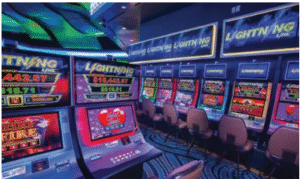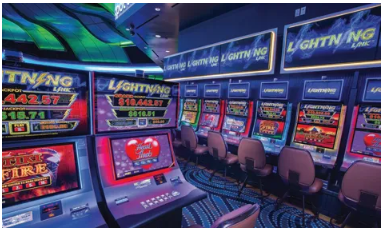The Enduring Spin of Slot Machines
The Enduring Spin of Slot Machines. The slot machine hums to life, its reels spinning in a blur of cherries, sevens, and glittering symbols. A lever is pulled—or more likely, a button pressed—and the anticipation builds with each clink and whir. Then, the reels stop, and for a moment, time does too.
A jackpot jingle or a quiet thud signals the outcome, and the cycle begins again. Slot machines, those iconic fixtures of casinos and arcades, have a magic that’s hard to resist. They’re simple, flashy, and built on the promise of instant fortune, drawing millions to their reels year after year. But what is it about slots that makes them so captivating, and how did these mechanical marvels become a cornerstone of modern gambling?

A Mechanical Beginning
The story of slot machines starts in the late 19th century, a time when inventors were tinkering with all sorts of contraptions. The first recognizable slot machine appeared in 1894, created by Charles Fey, a San Francisco mechanic.
His Liberty Bell machine was a simple device three spinning reels, each marked with symbols like horseshoes, stars, and the eponymous bell. Players inserted a nickel, pulled a lever, and hoped for a winning combination. A line of three Liberty Bells paid out the grand
prize of 50 cents—a small fortune at the time.
Fey’s invention was a hit, spreading quickly to bars, saloons, and cigar shops across America. These early machines were purely mechanical, relying on gears and springs to function. They offered no flashing lights or digital displays, but their simplicity was part of the charm. Players were drawn to the tactile thrill of pulling the lever and the suspense of watching the reels align.
By the early 20th century, slot machines faced legal challenges. Gambling laws in many states banned cash payouts, so manufacturers got creative. Machines began dispensing gum, candy, or tokens instead of money, with fruit symbols like cherries and lemons representing different flavors. This is why slots are still sometimes called “fruit machines.” Despite the workarounds, slots remained a cultural fixture, evolving with technology and societal shifts.
From Levers to Touchscreens
The slot machine as we know it today is a far cry from Fey’s Liberty Bell. The 1960s brought electromechanical slots, which replaced some manual components with electrical systems. These machines could offer bigger payouts and more complex features, like multiple paylines. The real revolution, though, came in the 1980s with the advent of video slots. Powered by microchips and random number generators (RNGs), video slots ditched physical reels for digital screens, opening the door to endless themes, bonus rounds, and progressive jackpots.
RNGs are the heart of modern slots, ensuring each spin is independent and unpredictable. The technology guarantees fairness (or at least, as fair as the house edge allows), but it also fuels the game’s addictive quality. Unlike poker or blackjack, where skill can tilt the odds, slots are pure chance. The house edge—typically 5-15% depending on the machine—ensures the casino’s long- term profit. Yet the possibility of a life-changing jackpot keeps players spinning.
Today’s slots are sensory overload machines, decked out with vibrant graphics, surround sound, and themes ranging from ancient Egypt to blockbuster movies. Walking through a casino, you’ll see machines based on Game of Thrones, Wheel of Fortune, or even heavy metal bands. Some offer progressive jackpots, where a small portion of each bet feeds a growing prize pool that can reach millions. Others tempt players with bonus games, free spins, or “near-miss” animations that make a loss feel like a win. It’s all carefully designed to keep you playing just one more spin.
The Psychology of the Spin
Slots are often called the “crack cocaine” of gambling, and there’s truth to that. Their design taps into deep psychological triggers. The flashing lights and celebratory sounds create a dopamine rush, even for small wins. The near-miss effect—when two jackpot symbols land just shy of the third—tricks the brain into thinking a win was close, encouraging another try. And the random payout structure, where wins come unpredictably, mirrors the reinforcement patterns of addiction.
Casinos know this and optimize every detail. Slot machines are placed in high-traffic areas, their sounds beckoning passersby. They’re designed for comfort, with ergonomic chairs and easy-to-reach buttons, so players can lose track of time. Some machines even adjust payouts dynamically, offering smaller, frequent wins to keep players hooked.
It’s no accident that slots generate more revenue for casinos than any other game—often 70-80% of their total take. Yet slots aren’t just about manipulation. They’re also about escapism. For many, a session at the slots is a chance to unwind, to step into a world of fantasy where a single spin could change everything. The grandmother playing a penny slot with her Social Security check, the tourist tossing in a few bucks for fun, the high roller chasing a million-dollar jackpot—they’re all chasing the same dream, even if their stakes differ.
The Enduring Spin Slots in Popular Culture
Slots have left an indelible mark on pop culture. They’re a staple of casino scenes in movies, from the gritty desperation of The Gambler to the glitzy excess of Ocean’s Eleven. They’ve inspired songs, TV shows, and even video games, their iconic imagery instantly recognizable. The “one-armed bandit,” as early mechanical slots were called, evokes a sense of nostalgia, even for those who’ve never pulled a lever.
The rise of online slots has only amplified their cultural reach. Virtual casinos offer thousands of games, accessible from a phone or laptop. Social media influencers stream their slot sessions, turning spins into entertainment for thousands of viewers. Slots have even infiltrated non-gambling spaces, with “slot-like” mechanics in mobile games that reward players with virtual coins or loot boxes. This gamification of everyday life owes a debt to the slot machine’s addictive design.
The Enduring Spin The Digital Revolution
Online slots, introduced in the 1990s, have transformed the industry. They offer convenience and variety,:with players able to switch from a pirate-themed game to a sci-fi adventure in seconds. Many online slots boast higher payout percentages than their land-based counterparts, often 95-98%, though the house edge still ensures long-term profits.
Live casino streams, where real dealers interact with players via webcam, add a social element to the digital experience. The downside of this accessibility is the risk of problem gambling. Online slots are available 24/7, with no closing time to force a break. Features like autoplay and in-game purchases can lead to rapid losses. Responsible gambling tools, like deposit limits and self-exclusion options, aim to address this, but the onus often falls on players to set boundaries.
The Enduring Spin Slots Endure
Slots have thrived for over a century because they’re endlessly adaptable. They’ve evolved from clunky machines in smoky bars to sleek digital platforms, yet their core appeal—chance, excitement, possibility—remains unchanged. They don’t require skill or strategy, making them accessible to everyone. They offer a fleeting escape, a moment where the next spin could be the one.
Picture yourself at a slot machine, the reels spinning under a cascade of lights. You’re not thinking about odds or house edges; you’re caught in the moment, riding the wave of what-if. Win or lose, it’s the thrill that keeps you there, the same thrill that’s drawn people to slots for generations. In a world of uncertainty, slots offer a controlled chaos—a game where anyone, for a fleeting second, can feel like luck is on their side.
